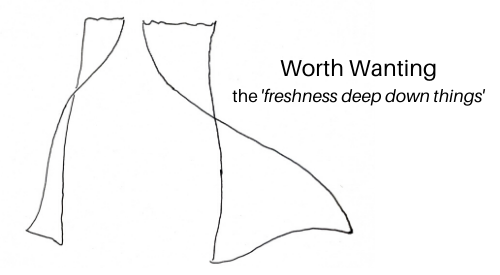
There’s a kind of conversation that thrills me, leaves me glowing, stimulates my best thoughts, an interchange that fills up both my mind and heart with what I reflect on for days afterward. It may happen around a table, or on a bench, or over the phone. It’s a memorable kind of event, and all too rare, especially nowadays. I’m not talking about salon wit or smart repartee, nor about heart-felt consultations or intimate chats. I call what I’m talking about ‘conversation of exploration’ or ‘convex’.
What makes convex work is a certain kind of thinking, one that’s at play in our encounters, and particularly accessible to transcendent freshness. This style of thinking is open three-C thinking, that is conjectural, creative and critical thinking working together to define a space wherein thoughts are generated, explored and shaped. Three-C thinking is different from SOS thinking: strategic, optimax and systems thinking, which is more appropriate for considerations of achievement (and power), performance (and profit) and maintenance (and perpetuation).
Closed three-C thinking ends with right solutions as in detection or with right actions or attitudes as in wisdom. Open three-C thinking, however, doesn’t end but does stops when an array of ideas and its arc of development is characterized by an interestingness, individually and as a whole, impressive, intriguing or intimate enough to require rest and assimilation. Closed three-C thinking comes to a final point; open-ended three-3 thinking always stays open and ready to develop.
(I describe closed three-C thinking through to definite conclusions as thought projects in a paper I wrote several years ago. On reflection, I realize there is open three-C kind of thinking that is aimed more at generating and tracking interestingness, and not at generating anything immediately deliverable. For more on thinking spaces, thinking questions, and related matters, go to the link here.)
The takeaways of open-ended three-C thought are not just concise lessons to learn or teach for better results next time, but dynamic responses of our livingness (its contours, constituents, internal configuration), often slow and unforeseeable in their expression, to the reverberations and repercussions and resonances ( occasioned by encounters.
Open three-C thinking mirrors the manifestations of freshness in several ways.
Each of the coordinates of the three dimensions of three-C thought space–creativity, conjecture and critical analysis (dividing and combining)–are, like the number line, infinitely extensible and expandable. Hence the roominess, and sense of beyondness.
In three-C thought space, notions and their penumbras of implication interacting with one other, give birth, gradually or explosively, to new unsuspected and unpredictable new notions with wild and unexpected implications extending who knows how far, involving who knows what. Hence real novelty.
Three-C thought is most lively in the freedom and inspiration afforded by the permissions and down-to-earth particularities of hospitality, friendship and exploration, unhampered by the tyranny of specific targets and the intimidation of predetermined indicators. Hence common cause.
The glamour of individual ideas, the interplay of penumbras of implication, the dramas of slow realization and sudden insight, the paths of thought streams as they evolve, can impress us, intrigue us and sometimes touch us intimately, the sum of which is an occasion capable of engendering other such occasions. Hence interestingness.
Those great conversations we have over dinner or late at night or with friends, the ones that, in retrospect, seem incandescent, are exercises in group open-ended 3-C thinking.
SOS thinking is very practical and appropriate to the mundane world while open three-3 thinking is very compatible with the transcendent world. We need both, of course, to navigate both the world we are born into and the one we are invited to participate in and contribute to.
And even if as rare as a comet sighting, any convex is an epitome of the joy of life.
